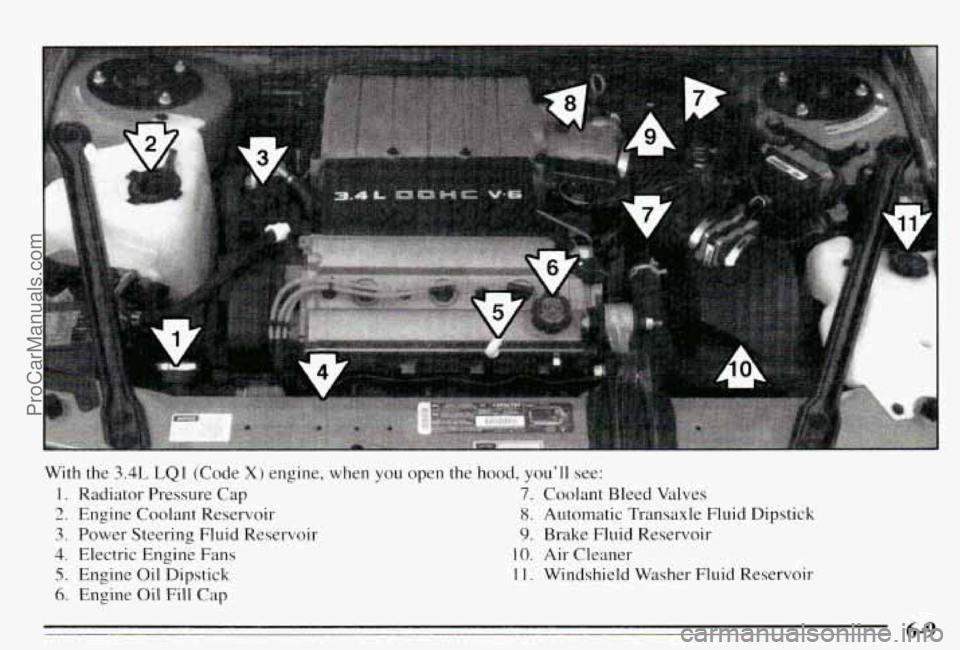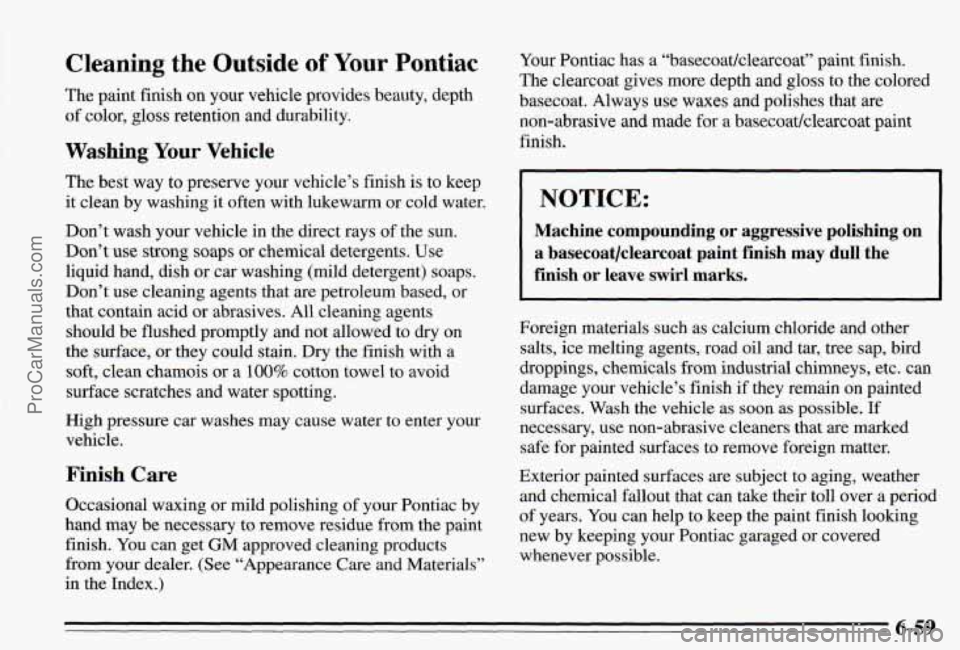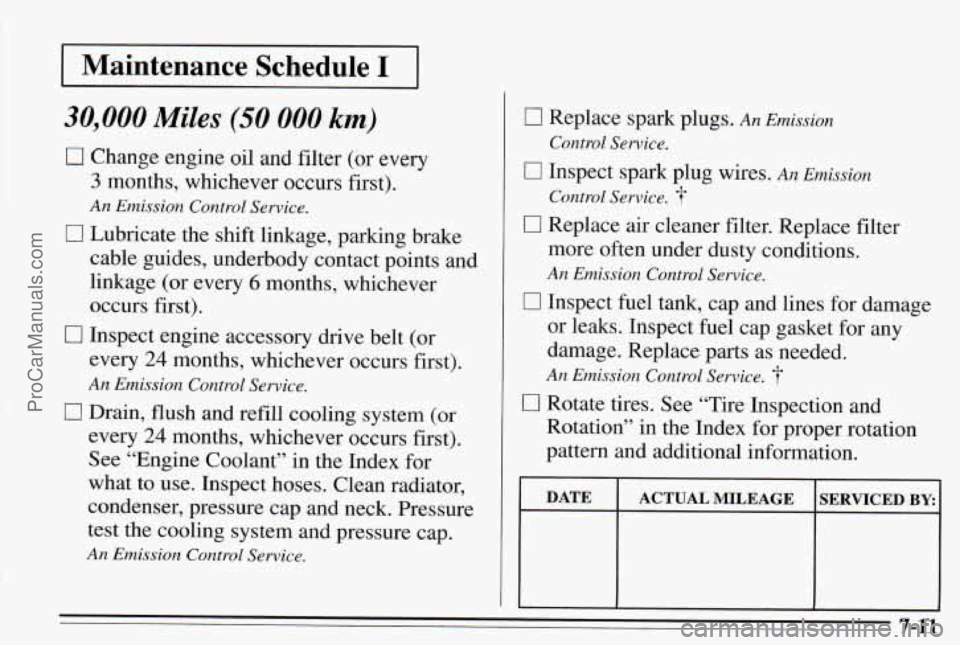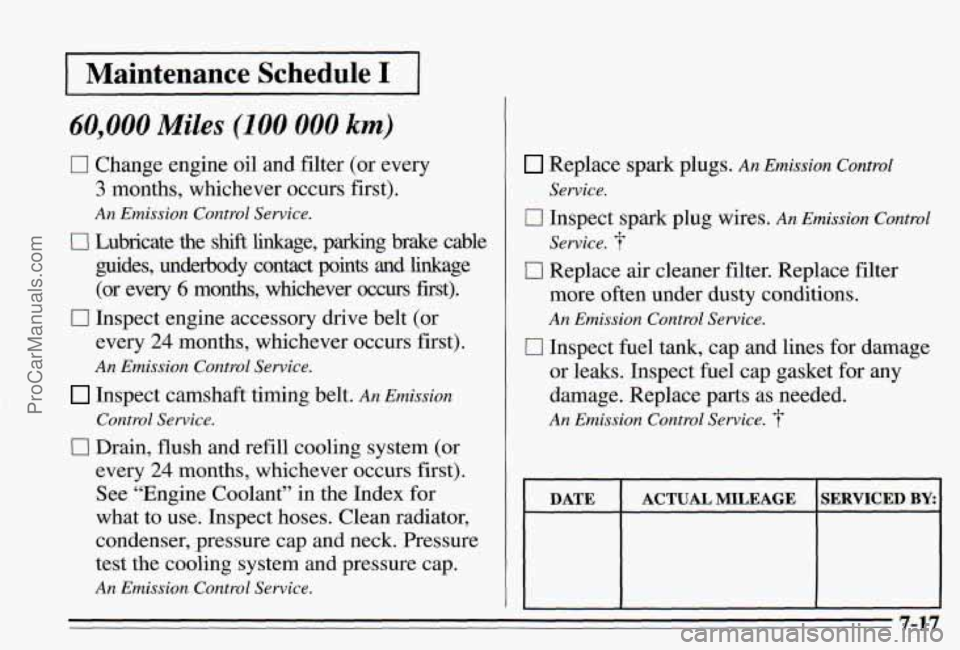1995 PONTIAC PONTIAC oil pressure
[x] Cancel search: oil pressurePage 6 of 354

Vehicle Symbols
These are some of the symbols you may find on your vehicle.
For example,
these symbols
are used on an
original battery;
POSSIBLE A
CAUTION
INJURY
PROTECT EYES BY
SHIELDING
CAUSTIC
ACID COULD BATTERY
CAUSE
BURNS
AVOID
SPARKS
OR
FLAMES
SPARK
OR ,\I/,
COULD FLAME
EXPLODE BATTERY
These symbols
are important
for
you and
your passengers
whenever your
vehicle is
driven:
DOOR LOCK
UNLOCK
FASTEN SEAT
BELTS
S
These symbols
have to
do with
your lights:
SIGNALS e
TURN
HIGH
LAMPSoR BEAM = =o
FOG LAMPS $0
These symbols
are
011 some of
your controls:
WINDSHIELD WIPER
WINDSHIELD DEFROSTER
WINDOW
DEFOGGER
VENTILATING
a+
FAN w*
These symbols
are used
on
warning and
indicator lights:
COOLANT F-
ENGINE
TEMP
- k
CHARGING BATTERY
SYSTEM
BRAKE
(0)
RADIATOR COOLANT
a
FUEL
ENGINE OIL
PRESSURE
Wb
TEMP OIL &
ANTI-LOCK (@)
BRAKE
Here are some
other symbols
you may see:
FUSE
RELEASE RADIO
k
VOLUME a
CONDITIONING AIR 33
RELEASE TRUNK ru
t
LIGHTER m
SPEAKER
b
V
ProCarManuals.com
Page 163 of 354

Once you are moving on the freeway, make certain you
allow
a reasonable following distance, Expect to move
slightly slower at
night.
When you want to leave the freeway, move to the proper
lane well in advance.
If you miss your exit do not, under
any circumstances, stop and back up. Drive on to the
next exit.
The exit ramp can be curved, sometimes quite sharply.
The exit speed is usually posted.
Reduce
your speed according to your speedometer, not
to your sense of motion. After driving
for any distance
at higher speeds, you may tend to think you are going
slower than you actually are.
Before Leaving on a Long Trip
Make sure you’re ready. Try to be well rested. If you
must start when you’re not fresh
-- such as after a day’s
work
-- don’t plan to make too many miles that first part
of the journey. Wear comfortable clothing and shoes you
can easily drive in.
Is your vehicle ready for a long trip? If you keep it
serviced and maintained, it’s ready to go. If it needs
service,
have it done before starting out. Of course,
you’ll find experienced and able service experts in
Pontiac dealers
all across North America. They’ll..be
ready and willing
to help if you need it.
Here are some things you can check before a trip:
e
0
0
0
0
e
0
Windshield Washer Fluid: Is the reservoir full? Are
all windows clean inside and outside?
Wiper Blades: Are they in good shape?
Fuel, Engine Oil, Other Fluids: Have you checked
all levels?
Lamps: Are they all working? Are the lenses clean?
Tires: They are vitally important to a safe,
trouble-free trip.
Is the tread good enough for
long-distance driving? Are the tires all inflated to the
recommended pressure?
Weather Forecasts: What’s the weather outlook
along your route? Should you delay your
trip a short
time to avoid a major storm system?
Maps: Do you have up-to-date maps?
4-20
ProCarManuals.com
Page 221 of 354

I
a3
7
With the 3.1 L L82 (Code M) engine, when you open the hood, you’ll see:
1. Radiator Pressure Cap 7. Engine Oil Dipstick
2. Engine Coolant Reservoir 8. Automatic Transaxle Fluid Dipstick
3. Power Steering Fluid Reservoir 9. Brake Fluid Reservoir
4. Coolant Bleed Valves 10. Air Cleaner
5. Electric Engine Fans 11. Windshield Washer Fluid Reservoir
6. Engine Oil Fill Cap
6-8
ProCarManuals.com
Page 222 of 354

'4 L,
With the 3.4L LQI (Code X) engine, when you open the hood, you'll see:
1. Radiator Pressure Cap 7. Coolant Bleed Valves
2. Engine Coolant Reservoir 8. Automatic Transaxle Fluid Dipstick
3. Power Steering Fluid Reservoir 9. Brake Fluid Reservoir
4. Electric Engine Fans 10. Air Cleaner
5. Engine Oil Dipstick 1 1. Windshield Washer Fluid Reservoir
6. Engine Oil Fill Cap
6-9 ProCarManuals.com
Page 269 of 354

Using Solvent-Type Cleaner on Fabric
First, see if you have to use solvent-type cleaner at all.
Some spots and stains will clean off better with just
water and~mild soap.
If you need to use a solvent:
0 Gently scrape excess soil from the trim material
with a clean, dull knife or scraper. Use very little
cleaner, light pressure and clean cloths (preferably
cheesecloth). Cleaning should
start at the outside
of the stain, “feathering” toward the center. Keep
changing
to a clean section of the cloth.
When you clean a stain from fabric, immediately dry
the area with a blow dryer to help prevent a cleaning
ring. (See the previous
NOTICE.)
Special Cleaning Problems
Greasy or Oily Stains
Stains caused by grease, oil, butter, margarine, shoe
polish, coffee with cream, chewing gum, cosmetic
creams, vegetable oils, wax crayon, tar and asphalt can
be removed as follows:
0 Carefully scrape off excess stain.
Follow the solvent-type instructions described
Shoe polish, wax crayon, tar and asphalt will stain if
left on
a vehicle seat fabric. They should be removed
as
soon as possible. Be careful, because the cleaner
will dissolve them and may cause them to spread.
earlier.
Non-Greasy Stains
Stains
caused by catsup, coffee (black), egg, fruit, fruit
juice,
milk, soft drinks, wine, vomit, urine and blood can
be removed as follows:
0 Carefully scrape off excess stain, then sponge the
If a stain remains, follow the foam-type instructions
soiled area with
cool water.
described earlier.
6-56
ProCarManuals.com
Page 272 of 354

Cleaning the Outside of Your Pontiac
The paint finish on your vehicle provides beauty, depth
“ color, gloss retention and durability.
Washing Your VehicIe
The best way to preserve your vehicle’s finish is to keep
it clean by washing it often with lukewarm or cold water.
Don’t wash your vehicle in the direct rays of the sun.
Don’t use strong soaps
or chemical detergents. Use
liquid hand, dish or car washing (mild detergent) soaps.
Don’t use cleaning agents that are petroleum based, or
that contain acid or abrasives. All cleaning agents
should be flushed promptly and not allowed to dry on
the surface, or they could stain. Dry the finish with a
soft, clean chamois or a
100% cotton towel to avoid
surface scratches and water spotting.
High pressure car washes may cause water to enter your
vehicle.
Finish Care
Occasional waxing or rnild polishing of your Pontiac by
hand may be necessary to remove residue from the paint
finish. You can get
GM approved cleaning products
from your dealer. (See “Appearance Care and Materials”
in the Index.)
Your Pontiac has a “basecoatklearcoat” paint finish.
The clearcoat gives more depth and gloss to the colored
basecoat. Always use waxes and polishes
that are
non-abrasive and made
for a basecoatklearcoat paint
finish.
I NOTICE:
Machine compounding or aggressive polishing on
a basecoat/clearcoat paint finish may dull the
finish or leave swirl marks.
Foreign materials such as calcium chloride and other
salts, ice melting agents, road oil and tar, tree sap, bird
droppings, chemicals from industrial chimneys, etc.
can
damage your vehicle’s finish if they remain on painted
surfaces. Wash the vehicle as soon as possible.
If
necessary, use non-abrasive cleaners that are marked
safe for painted surfaces to remove foreign matter.
Exterior painted surfaces are subject to aging, weather
and chemical fallout that can take their toll over a period
of years. You can help to keep the paint finish looking
new by keeping your Pontiac garaged or covered
whenever possible.
6-59
ProCarManuals.com
Page 298 of 354

Maintenance Schedule I
30,000 Miles (50 000 km)
0 Change engine oil and filter (or every
3 months, whichever occurs first).
An Emission Control Service.
0 Lubricate the shift linkage, parking brake
cable guides, underbody contact points and
linkage (or every
6 months, whichever
occurs first).
17 Inspect engine accessory drive belt (or
every
24 months, whichever occurs first).
An Emission Control Service.
0 Drain, flush and refill cooling system (or
every
24 months, whichever occurs first).
See “Engine Coolant’’ in the Index for
what
to use. Inspect hoses. Clean radiator,
condenser, pressure cap and neck. Pressure
test the cooling system and pressure cap.
An Emission Control Service.
0 Replace spark plugs. An Emission
0 Inspect spark plug wires. An Emission
0 Replace air cleaner filter. Replace filter
Control Service.
Control Sewice.
3-
more often under dusty conditions.
An Emission Control Sewice.
0 Inspect fuel tank, cap and lines for damage
or leaks. Inspect fuel cap gasket for any
damage. Replace parts as needed.
An Emission Control Service. 3-
0 Rotate tires. See “Tire Inspection and
Rotation” in the Index for proper rotation
pattern and additional information.
DATE ACTUAL MILEAGE SERVICED BY:
7-11 ProCarManuals.com
Page 304 of 354

Maintenance Schedule. 1
60,000 Miles (100 000 km)
-
0 Change engine oil and filter (or every
3 months, whichever occurs first).
An Emission Control Service.
0 Lubricate the shift linkage, parking brake cable
guides, underbody contact points and linkage (or every
6 months, whichever occurs first).
every
24 months, whichever occurs first).
An Emission Control Service.
0 Inspect engine accessory drive belt (or
Inspect camshaft timing belt. An Emission
0 Drain, flush and refill cooling system (or
every
24 months, whichever occurs first).
See “Engine Coolant” in the Index for
what to use. Inspect hoses. Clean radiator,
condenser, pressure cap and neck. Pressure
test the cooling system and pressure cap.
An Emission Control Service.
Control
Service.
Replace spark plugs. An Emission Control
0 Inspect spark plug wires. An Emission Control
0 Replace air cleaner filter. Replace filter
Service.
Service.
more often under dusty conditions.
An Emission Control Sewice.
CI Inspect fuel tank, cap and lines for damage
or leaks. Inspect fuel cap gasket
for any
damage. Replace parts as needed.
An Emission Control Service.
7-17
ProCarManuals.com